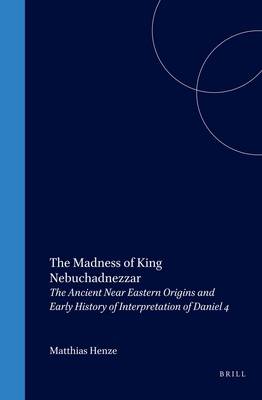
- Afhalen na 1 uur in een winkel met voorraad
- Gratis thuislevering in België vanaf € 30
- Ruim aanbod met 7 miljoen producten
- Afhalen na 1 uur in een winkel met voorraad
- Gratis thuislevering in België vanaf € 30
- Ruim aanbod met 7 miljoen producten
Zoeken
The Madness of King Nebuchadnezzar
The Ancient Near Eastern Origins and Early History of Interpretation of Daniel 4
Matthias Henze
€ 296,45
+ 592 punten
Omschrijving
In the mythic lore of the Ancient Near East, the trope of animalization contains a wealth of interpretive potential. The account of Nebuchadnezzar's madness in Daniel 4, the most potent example of this mythic trope in the Hebrew Bible, has provoked much fanciful elaboration among early biblical interpreters.
After a study of the many ancient variants of the ubiquitous tale, the book investigates the Ancient Near Eastern background of Nebuchadnezzar's transformation. The discussion then turns to the early reception of Daniel 4 in rabbinic Judaism, the Western Fathers and, most importantly, the Syriac tradition. A number of Syriac texts from the fourth century onward explicitly draw on the model of Nebuchadnezzar as the basis for a newly evolving ascetic discipline.
After a study of the many ancient variants of the ubiquitous tale, the book investigates the Ancient Near Eastern background of Nebuchadnezzar's transformation. The discussion then turns to the early reception of Daniel 4 in rabbinic Judaism, the Western Fathers and, most importantly, the Syriac tradition. A number of Syriac texts from the fourth century onward explicitly draw on the model of Nebuchadnezzar as the basis for a newly evolving ascetic discipline.
Specificaties
Betrokkenen
- Auteur(s):
- Uitgeverij:
Inhoud
- Aantal bladzijden:
- 298
- Taal:
- Engels
- Reeks:
- Reeksnummer:
- nr. 61
Eigenschappen
- Productcode (EAN):
- 9789004114210
- Verschijningsdatum:
- 14/10/1999
- Uitvoering:
- Hardcover
- Formaat:
- Genaaid
- Afmetingen:
- 167 mm x 244 mm
- Gewicht:
- 698 g

Alleen bij Standaard Boekhandel
+ 592 punten op je klantenkaart van Standaard Boekhandel
Beoordelingen
We publiceren alleen reviews die voldoen aan de voorwaarden voor reviews. Bekijk onze voorwaarden voor reviews.








